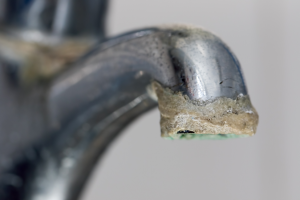Advice from a Frankfort Water Softening Company: Dealing with Calcium and Magnesium in Your Water
 While there are all sorts of contaminants in water, two of the most common are calcium and magnesium. Sure, these minerals have their benefits. However, their benefits are far outweighed by their downsides.
While there are all sorts of contaminants in water, two of the most common are calcium and magnesium. Sure, these minerals have their benefits. However, their benefits are far outweighed by their downsides.
Dealing with calcium and magnesium in your water? Here are some insights from a Frankfort water softening company.
How Do Calcium and Magnesium Get into Water?
First, you might be wondering how calcium and magnesium get into water in the first place. The answer is: the ground. The ground is filled with calcium and magnesium, and when water is pulled up from it, much of this calcium and magnesium come up with it.
The levels of calcium and magnesium existing in a water supply are dependent on the levels of calcium and magnesium existing in the ground. Here in Frankfort, the soil’s calcium and magnesium levels are high. As such, the calcium and magnesium levels in our water are high as well.
What are the Effects of Calcium and Magnesium in Water?
Unfortunately, the calcium and magnesium in water can have a number of negative effects. The most prominent of these negative effects include the following.
Clogged Water Pipes
One of the negative effects of calcium and magnesium in water is clogged water pipes. Over time, calcium and magnesium cling to the interior walls of water pipes, gradually building up and causing restriction. As a result, water pressure can reduce substantially.
Limescale Buildup
Just as calcium and magnesium build up on the insides of water pipes, they also build up on the tops of sinks and shower heads. While they cause these sinks and showerheads no functional impairment, they do disturb them cosmetically, appearing as a white, chalky substance. This substance is known as limescale.
Lack of Soap Suds
When water and soap are mixed, soap suds arise. Unfortunately, when calcium and magnesium exist within the water, they disturb the reaction between soap and water, resulting in a lack of soap suds. As such, calcium and magnesium-filled water often has trouble cleaning items thoroughly.
Brittle Hair
When calcium and magnesium make contact with human hair, they cling. Unfortunately, their clinging disturbs the consistency of the hair, often leading to brittleness and split ends.
Dry Skin
Just as calcium and magnesium cling to the hair, they also cling to the skin. Unfortunately, when they cling to the skin, they tend to clog up pores. As a result, vital oils can’t be secreted, and the skin becomes dry. This leads to a range of problems, including eczema and acne to name just two.
How Do You Remove Calcium and Magnesium from Water?
Fortunately, it’s very easy to remove calcium and magnesium from water. All you need to do is install a water softener. A water softener is a device that removes calcium and magnesium ions from water and exchanges them with sodium ions.
To have a water softener installed, all you need to do is call up your local water conditioning company. They can install your system for you, ensuring that it’s operating as intended.
Utilize the Services of a Frankfort Water Softening Company Today
Is there an excess of calcium and magnesium in your water? Looking to remove it? If so, and if you’re looking to utilize the services of a Frankfort water conditioning company, Johnson Water Conditioning is ready to help.
We manufacture only the best in residential water softeners and have installed them in countless Frankfort area homes. Our team would be happy to help you as well.
Contact us today to schedule an appointment!

 Better Water for
a Better Life
Better Water for
a Better Life
